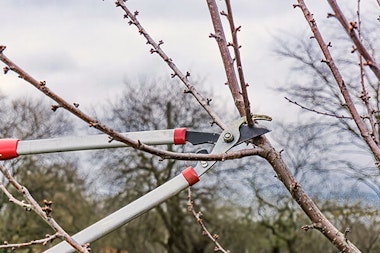 Be Inspired Blog - Arizona
Be Inspired Blog - Arizona

Winter Fruit Tree Care: Essential Tips for Desert Gardeners
Winter is a crucial time for fruit tree care, even in our mild desert climate. While the Valley is known for its warm weather, winter brings occasional frosts that can harm sensitive fruit trees. Proper care during these months ensures healthy trees and bountiful harvests in the coming seasons. Keep reading to learn how to keep your fruit trees thriving during the winter.
1. Protect Fruit Trees from Frost
 Frost is the biggest winter challenge for fruit trees in the Valley. Although frosts are relatively rare, they can damage or kill sensitive trees such as citrus, stone fruits, tropical, and sub-tropical varieties, as well as young deciduous fruit trees.
Frost is the biggest winter challenge for fruit trees in the Valley. Although frosts are relatively rare, they can damage or kill sensitive trees such as citrus, stone fruits, tropical, and sub-tropical varieties, as well as young deciduous fruit trees.
- Use Frost Covers: Cover your trees with frost cloth during cold nights. Ensure the cover reaches the ground to trap heat and secure it with rocks or stakes.
- Add Heat Sources: Place a small light bulb or string of non-LED holiday lights under the frost cover to provide gentle warmth. Avoid high-heat sources like heat lamps, which can scorch the tree.
- Mulch Around the Base: A thick layer of organic mulch (3–4 inches) insulates the roots and retains soil warmth. Keep mulch a few inches away from the trunk to prevent rot.
- Water Before a Frost: Moist soil retains heat better than dry soil. Watering your trees a day or two before a frost can help protect their roots and lower branches.
2. Adjust Watering in Winter
Winter dormancy reduces the water needs of most fruit trees. Overwatering can lead to root rot and other problems.
- Citrus Trees: Citrus trees remain semi-active during winter and need water every 2–3 weeks. Check the soil moisture 6 inches below the surface to determine when to water.
- Deciduous Trees: Water deeply every 3–4 weeks during dormancy if there’s no rain. Ensure the soil dries slightly between waterings.
- Tropical & Sub-Tropical Fruits: Tropical fruits like mango, papaya, and guava are frost-sensitive and require extra care. Protect them with frost cloths and consider using potted fruit trees indoors during extreme cold. Water sparingly during winter to avoid root rot.
3. Prune for Health and Productivity
 Pruning shapes the tree, removes dead wood, and prepares it for spring growth. Timing and technique are key:
Pruning shapes the tree, removes dead wood, and prepares it for spring growth. Timing and technique are key:
- Citrus Trees: Avoid heavy pruning in winter to prevent exposing sensitive wood to frost. Focus on removing suckers, weak branches, and any dead or diseased wood.
- Deciduous Trees: Prune during full dormancy (December to February). Remove dead, damaged, or crossed branches and thin out the canopy for better air circulation and sunlight penetration.
- Stone Fruits: Peaches, plums, and apricots require pruning during dormancy to remove diseased wood and shape the tree. Focus on thinning the canopy to improve light penetration and fruit quality. Avoid late winter pruning, which may stimulate premature growth.
Click the button below to watch our How-to Prune video:
4. Apply Dormant Sprays
Dormant sprays protect trees from overwintering pests and diseases like peach leaf curl, fire blight, and scale insects.
- When to Spray: Apply dormant sprays to deciduous fruit trees in late December or January, when they are fully dormant.
- Choosing the Right Spray: Use a horticultural oil or copper-based fungicide. Copper sprays are particularly effective against fungal diseases.
- Application Tips: Spray on a clear, dry day with temperatures above 40°F and no rain expected for 24 hours. Coat the trunk and branches thoroughly.
- Citrus & Sub-Tropical Fruits: Dormant sprays are generally unnecessary for citrus and tropical fruits unless specific pests like scale are present.
 5. Prepare the Soil and Add Mulch
5. Prepare the Soil and Add Mulch
Healthy soil sets the foundation for healthy trees:
- Soil Testing: Check pH and nutrient levels to ensure optimal growing conditions. Amend the soil with compost or fertilizers based on the results.
- Add Mulch: Mulch not only insulates roots but also suppresses weeds and retains moisture. Use organic materials like wood chips, straw, or bark.
6. Monitor for Pests & Diseases
Winter is a good time to inspect your trees for signs of pests or diseases:
- Pests: Look for scale insects, aphids, and spider mites. Remove overwintering pests by hand or with horticultural oils.
- Diseases: Rake up and dispose of fallen leaves or fruit to prevent the spread of fungal diseases.
 7. Wait Until Spring to Fertilize
7. Wait Until Spring to Fertilize
- Citrus Trees: Begin fertilizing in February or March with a citrus-specific fertilizer to support new growth.
- Deciduous Trees: Hold off on fertilizing until buds start to swell in late winter or early spring.
- Stone Fruits: Wait until the buds begin to swell before fertilizing. Use a balanced fertilizer to promote strong early growth.
- Tropical & Sub-Tropical Fruits: Fertilize lightly in late winter to encourage early spring growth. Use a balanced fertilizer for tropical fruit trees like mangoes and bananas.
By following these winter care tips, your fruit trees will be well-prepared for spring growth and a productive harvest. Whether you’re tending to citrus or deciduous, tropical, or stone fruit varieties, small adjustments to watering, pruning, and frost protection can make a big difference. With proper attention, your desert backyard orchard will continue to thrive despite the challenges of our desert winter.

